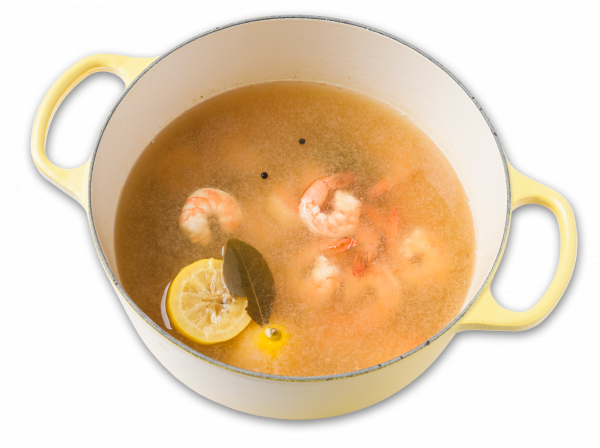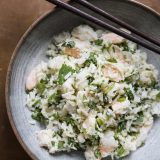
We sometimes buy precooked shrimp in a pinch, but they often are rubbery and tasteless. Poaching your own not only is quick and easy, it also delivers better texture and allows you to flavor the cooking water.
In a Dutch oven, bring to a boil 8 cups water, 1 lemon (halved and juice squeezed into the water), 5 bay leaves, 1 tablespoon whole black peppercorns and 1 teaspoon whole cloves. Boil for 3 minutes, then remove from the heat. Add 1 pound uncooked shrimp (peeled and deveined). Cover and let stand until the shrimp are opaque and cooked through, 4 to 5 minutes. Drain, then quickly transfer to a bowl of ice water to stop the cooking. Once cold, drain, discard seasonings and transfer to a paper towel-lined bowl. Dry well before using.
Gardens in northeast Malaysia overflow with aromatic plants unfamiliar to most of us—wild betel, turmeric, flowering torch ginger, galangal, makrut lime—as well as more common lemon grass, mint, cilantro and many types of basil.
And they all play a role in nasi ulam, a richly herbal and vibrantly textured rice salad. Rooted in traditional medicine, it originally was intended to cleanse the body of toxins, says Christina Arokiasamy, author of “The Malaysian Kitchen.”
“What nasi ulam is, is a whole bunch of goodness in one bowl,” she says, noting that the dish evolved after the arrival of Chinese immigrants in the 15th century. Their descendants intermarried with locals, adopted the dish and added coconut and fried fish, then served it with a spicy sambal chili sauce. The result is a pleasant cacophony of flavors and textures defined by vivid, bright contrasts.
Despite the lengthy list of herbs and seasonings, making nasi ulam is a simple process. Cooks prepare jasmine rice, scenting the cooking water with one or more of the herbs and often coconut milk. After the rice cools, the remaining herbs are thinly sliced and stirred in, keeping their flavors fresh, not cooked. Savory fish sauce or shrimp paste adds richness, and fried fish adds substance.
At Milk Street, we loved the combination of ample fresh herbs paired with rice and savory seafood. But we needed to simplify. We started with the herbs, limiting our recipe to basil, cilantro and mint. We replicated the subtle taste of makrut lime leaves by adding lime juice to the dressing. And in lieu of fried fish, we found that poached shrimp—soaked briefly in the coconut milk dressing—added briny meatiness that complemented the herbs and citrus.
The resulting dish was light but intensely fragrant, with a slight sweetness from the coconut and shrimp and a brightness from ginger and lime juice—a taste of Malaysia made more familiar.
Related Recipes
July-August 2019

Sign up to receive texts
Successfully signed up to receive texts!
We'll only send our very best offers - Like a $15 store credit to start.
By entering your phone number and submitting this form, you consent to receive marketing text messages (such as promotion codes and cart reminders) from Christopher Kimball's Milk Street at the number provided, including messages sent by autodialer. Consent is not a condition of any purchase. Message and data rates may apply. Message frequency varies. You can unsubscribe at any time by replying STOP or clicking the unsubscribe link (where available) in one of our messages. View our Privacy Policy and Terms of Service.



